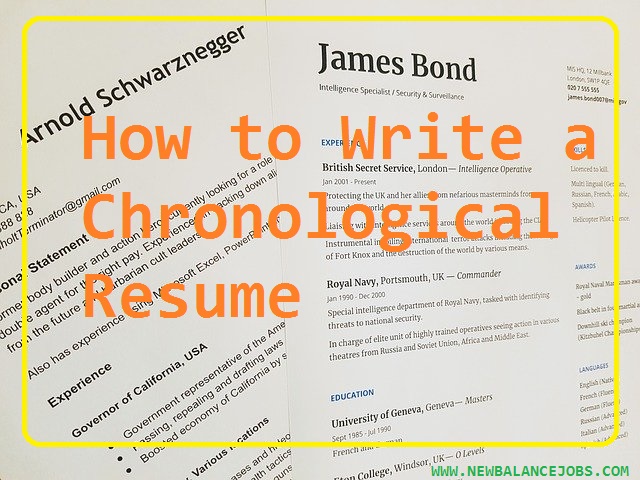Introduction on how to Write a Chronological Resume
A Chronological Resume is one of the three main forms of CV. This format draws attention to your business experience. Your current position or position is first listed first, and it continues in reverse chronological order for the remainder of your employment history. Chronological CV format, also known as “reverse chronology”, narrates your experience from most to less recent.
This format is best used by those with a steady work history and increased job levels over time. If you have major gaps in your career or change industries or positions multiple times, you might consider using a functional or mixed CV format.
This CV lists your work history in reverse chronological order (i.e. starting with the most recent job first). This type of CV gives you the opportunity to give a place of prominence to your talents, skills and recent and distinguished experiences, ensuring that the hiring manager is interested enough to read your entire CV.
Do I need a Chronological Resume?
If you have a direct work history – a date where you have practical experience in the field of work you are targeting, and with a few large gaps in unemployment – then a time CV is the way to go.
Although it is a good idea to include two or three job descriptions in the “Professional Experience” section, you should not submit more than 15 years of work history. Doing so may examine your request by employers guilty of “anti-aging bias”.
You May Also Like; How to start an HR Consulting Business
It is also common to place your education and activities in their own section or sections, rather than mixing it with your work experience.
If you have gone to graduate school or have multiple learning experiences, you still have to include them in reverse chronological order within your education department, to achieve consistency.
How to Write a Chronological Resume

Your resume must contain three parts of its general structure. Start your resume with a header in the middle of the page with your full name, phone number, email address and city of residence if you wish.
Next, be sure to include a brief statement. While most CVs are used to start with objective data, the Digest Statement came to replace the goal in part because it conveys more information about your unique qualifications. Use about 4-6 lines to convey your most important experience, education, and skills using parts of sentences.
Finally, create a “Experience” section to clarify the details of your work, volunteer and other important experiences. Coordinate this section of your resume in chronological order.
What is the Order of a Chronological Resume?
- Contact information – vital information, so it appears prominently on top of your CV.
- Resume Goal – The CV’s goal is an introduction that briefly outlines your experiences and skills.
- Work Experience – here, summarize your current and past jobs in reverse chronological order.
- Basic Skills Sections – The purpose of the Basic Skills section is to demonstrate your traits and skills. Remember to include a mixture of soft and hard skills.
- Education – State your degree, where it was obtained, and your GPA. Other certificates may be added as well.
- Achievements – Be it employee of the week or something from college, note the relevant awards and honors here.
Your resume is best chronological when you have worked most of your career in similar fields, especially when you have moved up within an industry as shown in the history of your career. However, it is not ideal if you lack the applicable work history.
An alternative to chronological resume format is to format a functional CV, placing the most relevant jobs at the top of the CV, even if they are out of order. Some career CVs begin with skills rather than jobs, with purposeful exclusion from employment dates.
This format is recommended for people with very diverse work experiences, who completely change their jobs and people with significant gaps in employment history
Conclusion
A well written CV will go a long way in helping you find the job of your dreams. Biography is like the first impression. You only have one chance.
If your language is full of errors or lacks vital information, it is likely that you will not get that important interview, so be sure to review your CV carefully.
One of the advantages of chronological resume coordination is that it allows you to refer to all the different responsibilities or achievements of different situations in a bitmap or in a descriptive paragraph after each job.
This allows the hiring manager to see not only the work history with the corresponding dates, title and company, but also to review the accomplishments and jobs managed by the candidate while in this position.






